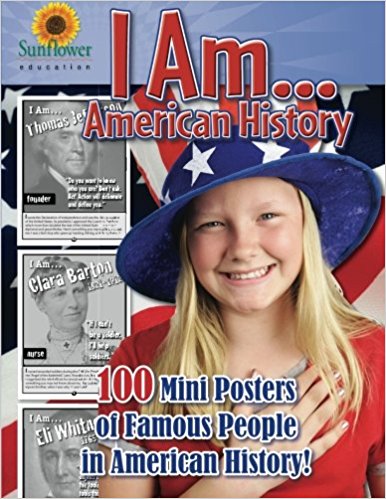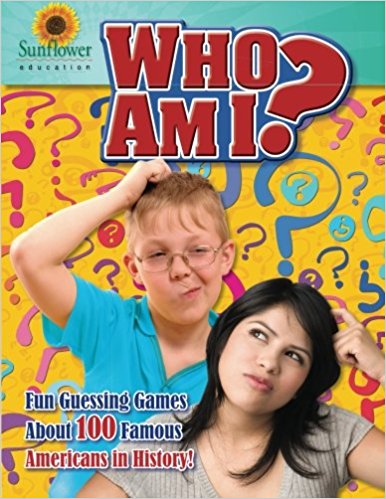Who Am I?: Fun Guessing Games About 100 Famous Americans in History should be a fun supplement for United States history for students in about grades four through eight. The book consists of 100 half-page size "cards," printed two per page. Each card has five clues that help to identify a famous American. Clues gradually shift from general to concrete. The first clue on each card says something like, “I am a man who lived from 1590 to 1657.” This often won’t be enough for students to pinpoint the person, so students can ask for the second clue. On this same card, the second clue is “I was a Puritan.” Clues continue: “I signed the Mayflower Compact,” “I wrote Of Plimoth Plantation,” and “I was elected 30 times to be Governor of Plymouth.” The person—in this case William Bradford— is not named on the card. Instead the cards are numbered and must be matched to a list in the book.
Cards can be used as a fun way to review key figures in American history, but they work well for competitive games. Either a single student or students competing against each other can be challenged to earn points by identifying people using the fewest clues: five points if you get it on the first clue but only one point if you need all five clues.
A simple game board for tracking points and some printed pawns are in the book, but I think using a more substantial game board and pawns would be more appealing. Almost any game board with a path should work.
With the printed book, you can use the clue cards directly from the book without taking them apart, but you will need to change the order in which you use them each time. The pages with the cards are printed on regular weight paper, so you might want to remove pages and laminate them. You can keep full pages with two cards per page or cut pages in half for individual cards. Cards are printed on both sides of each page so keep this in mind. If you want to be able to thoroughly mix the order of the cards, you might want to copy back sides of the cards to separate pages.
You can purchase a printed book or a PDF download. I recommend the PDF if you have easy access to color printing since the book is printed only in black and white while the PDF is in color. With the PDF, I recommend printing directly onto cardstock and printing only on one side of each page.

Students need to actually learn about the people featured on the cards, and they might not all be covered in your history textbook. So Sunflower Education also publishes I Am… American History: 100 Mini Posters of Famous People In American History. The 100 people are the same as those in Who Am I? and they are presented in the same order. This book is also available in print (black and white) or as a PDF download in color.
The mini posters are single-sided pages in the book. Each page has an image of the person from a photo or a painting. It tells the years in which they lived, the first clue on Who Am I? cards. Each page also includes a brief quotation, an identifying word such as president or scientist, and a paragraph with key facts. The paragraphs include many of the clues that will appear on the cards, but the information is not identical to what is on the cards.
The two resources work well together. You might select a group of famous people that fit within the time period students have studied to that point. Use the posters from I Am… American History to make sure they know about each person, then use the pertinent cards from Who Am I? to play a game for review. You can gradually use more mini posters while also adding cards to your game. While this does not provide comprehensive review, it covers a lot of information indirectly through the lives of famous Americans. Using the clues and the guessing game approach also helps develop critical thinking skills as students mentally sort through the possible answers.










